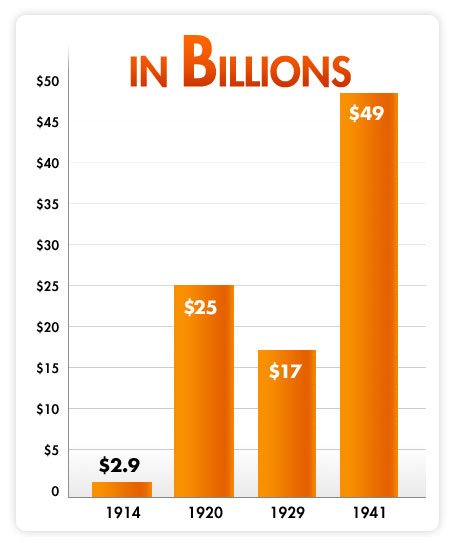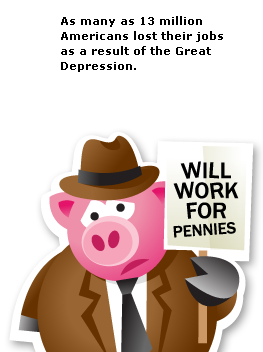
World War I (1914-1918) to the Great Depression (1929-1941)
The U.S. Government needed to raise money in preparation for their participation in World War I - the first major war between the countries of Europe in modern times. To do that, the Government raised taxes.
The Government also raised money by selling "Liberty Bonds." Americans bought the bonds to help the Government pay for the war. Later, they were paid back the value of their bonds plus interest. By the end of the war, the Government's debt was more than $25 billion.
After the war, the economies of many countries in Europe were in trouble.
- The price of necessities like food and fuel got much higher.
- Many people could not find jobs.
- It took more money to buy the same items than it did before the war. For example, before the war you paid 25 cents for a loaf of bread and after the war you paid $2.
In the U.S., however, the economy was strong. This period is often called "The Roaring '20s."
- The U.S. Government had more money than it needed to pay for the services it provided. This is known as a budget surplus.
- The Government's debt shrunk from $24 billion to around $17 billion.
- There was also a rise in profits from the stock market, which helped make some people rich.
Farming, however, did not do well. The price that farmers could get for their crops fell dramatically. If a bushel of corn before the war sold for $10, after the war it sold for $2. The cost of land increased too. That meant farmers could not afford to buy more land.
In 1929, the U.S. economy collapsed. This was the beginning of the Great Depression. One thing that triggered the Great Depression was the crash of the stock market on Tuesday, October 29, 1929. The value of stocks suddenly fell to very low levels. Some even lost all their value. This day is commonly called "Black Tuesday."
During the Great Depression:
- Many banks failed - going out of business without giving people their money back.
- Businesses closed and millions of people lost their jobs.
- The Depression spread to other countries causing their economies to collapse.
During the Depression, the Government's debt began to grow again since it was not collecting much money in taxes.

- 1914 - In preparation for its involvement in World War I, the U.S. Government raised money by selling "Liberty Bonds."
- 1920 - The Government's debt shrunk from $23 billion to $17 billion. The U.S. Government had more money than it needed to pay for the services it provided.
- 1929 - On October 29, known as "Black Tuesday," the U.S. economy collapsed. This was the beginning of the Great Depression.









